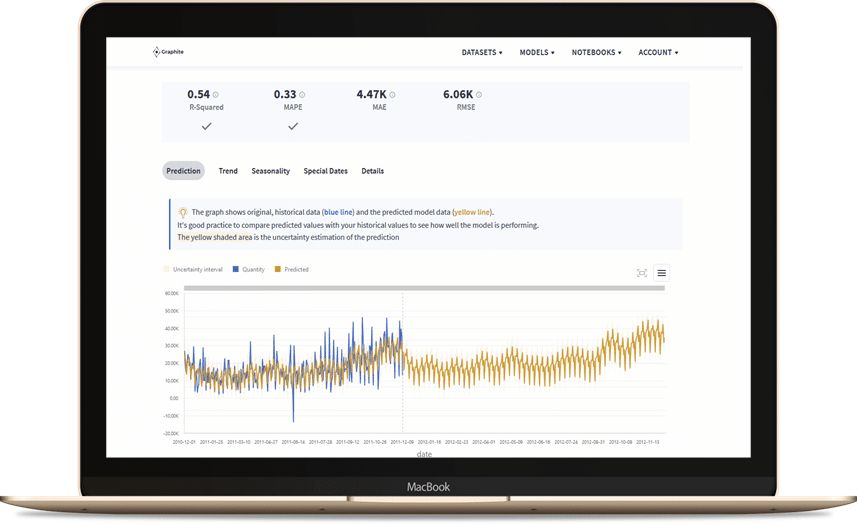What Is No-Code Automated Analytics?
As we contemplate the scarcity of data scientists, you may come across data science professionals who are expensive to hire.
You can’t blame professionals in the industry for charging what they’re worth. That also doesn’t mean you don’t have affordable alternatives. No-code automated analytics are the best, cost-friendly alternative.
No-code automated analytics are also known as autoML (automated machine learning). No-code automated analytics work like any standard artificial intelligence tool. Automated data analytics extract insights and patterns from data at incredible speed. These insights answer the questions like “What will happen in my business with X or Y?”

Data and Analytics
Data analytics is the broader field that encompasses the entire process. This includes collecting, cleaning, transforming, and analyzing data to extract valuable insights. When it comes to data and analytics, most businesses simply hire someone that they’ll train to handle their data-related needs. While this may be a good idea if you want a human representative on your team, it doesn’t always end well. Analytics tools are software applications designed to collect, clean, analyze, and visualize data.
Different types of analytics
Analytics tasks include data collection, cleaning, transformation, analysis, visualization, and reporting. Analytics processes can be standardized and automated to improve efficiency and consistency in data analysis. Analytical tasks such as data mining and statistical modeling can be automated. Predictive analytics leverages historical data and machine learning algorithms to forecast future trends and outcomes. Complex analytics involve advanced statistical techniques and modeling approaches to address intricate business problems. Advanced analytics goes beyond basic descriptive statistics. Advanced analytics uses sophisticated techniques to uncover deeper insights from data.

Automation tools
Automation tools can be integrated into your analytics workflow. Automation tools can automate repetitive tasks, saving time and resources. Process automation streamlines the flow of data from collection to insights generation. Artificial intelligence (AI) plays a crucial role in automated analytics. Machine learning algorithms automate tasks and uncover hidden patterns.
Data and machine learning
Data science is a field that combines statistics, computer science, and domain knowledge to extract insights from data. Data insights are valuable pieces of information. These are extracted from data analysis that can inform business decisions. Data analysts rely on data pipelines to automate the flow of data from various sources into a central repository. Data collection is the initial step in the data analytics process, where data is gathered from relevant sources. Machine learning models are algorithms trained on historical data. They make predictions or classifications on new data. Data scientists have the technical skills and knowledge to design, develop, and implement data analysis solutions.
The growing global data volume
The ever-growing global data volume necessitates the use of automated analytics tools to manage and analyze data. But, it’s not enough to simply analyze data. You need actionable insights too. Actionable insights derived from data analytics help you make informed decisions that drive business growth. Big data refers to massive and complex datasets that require specialized tools and techniques for analysis. Human intervention is still crucial in certain aspects of data analytics. Manual processes in data analysis can be time-consuming and prone to errors.
That can affect data quality. Ensuring excellent data quality is essential for ensuring the reliability and validity of the data insights. That means your data sources need to be well organized. Data sources encompass all the various locations from where data is collected, such as customer transactions, social media, and sensor data. Real-time insights enable businesses to make data-driven decisions based on the latest information.
Automated analytics
Analytics automation can help. Automated analytics eliminates the need for manual coding, streamlining the process of extracting insights from data. Automated data analytics empowers you to analyze structured and unstructured data, uncovering hidden patterns and trends. Also known as analytics automation, autoML uses tools and technologies to automate repetitive tasks within the data analysis workflow. An analytics workflow outlines the steps involved in data analysis, from data collection to data visualization and reporting. Effective automated analytics systems offer you a user-friendly interface, making data analysis accessible to even those without technical expertise. Even when you do hire a data scientist, data analytics automation frees up data scientists’ time to focus on more complex tasks, such as model development and strategic analysis. Automated data analysis gives you a faster turnaround time for reports and insights, allowing for quicker decision-making
A dual approach
That said, experts believe a dual approach is the most beneficial strategy. No-code AI takes existing data, scans it through machine learning technology, and predicts possible future outcomes. Automated analytics systems can help you because you don’t need to write a single line of code.
Your business growth
Your business growth can be accelerated by leveraging data analytics to identify trends, optimize operations, and target customers effectively. Business users can rely on the insights generated from data analytics to make informed decisions and achieve strategic objectives.
Who Is It For?
No-code automated analytics is a technology designed for any business owner, expert, or analyst. You don’t need programming knowledge to use a more cost-effective, automated solution to maximize the value of the data you collect. This way, you can keep an eye on your data without learning how to code.
Data scientists may not need to code every day, but it’s an essential skill they need to learn. After all, a data scientist knows analytics like no one else. For this very reason, people who choose this career path are often paid handsomely. Besides, they’re great at what they do, and the results you get are usually phenomenal.
Unfortunately, if statistics aren’t your strong suit, you may have difficulty catching up. This is where automated analytics software or autoML comes into play.

How Effective Are No-Code Automated Analytics Software?
It can feel like a mountain to climb for SMEs to implement machine learning so that has a positive effect on their business.
The apparent obstacle is acquiring the necessary skills to develop and implement AI solutions. That can present significant challenges, especially to SMEs, as hiring AI experts may not be financially feasible. Businesses could instead consider upskilling existing staff using online learning resources (many of them are free!) Alternatively, SMEs could look into low- or no-code AI development products and services.
What Is The Dual Approach?
The dual approach involves upskilling existing staff or hiring someone to keep track of your automated analytics for you. They’re in charge of making sure you get the proper results. And, depending on your agreement, they may even give you a strategy for moving forward.
Despite how progressive AI technology is, there is always the need for a human touch. Even with the added employee, you won’t have to worry about it costing as much as a data scientist professional would.
The Benefits Of No Code, Predictive Analytics
The most significant advantage of investing in automated predictive analytics software is keeping up with the data yourself. As a business owner with many things going on, it’s essential not to waste time staring at a screen full of data and not understanding a single thing about it. No-code machine learning tools simplify the process for you.
Here are some additional benefits you should know about:
More Cost-Efficient
Hiring a full-time data scientist is expensive. They charge anywhere from $30 to $200 an hour. That’s at least $86,400 a year spent on a single employee. Don’t even get me started on hiring someone with years of experience! It could cost you upwards of $500,000 annually.
When you’re a startup or small business just trying to get ahead of the competition, you may be reluctant to break the bank on such a considerable investment.
When following a dual approach, you’ll only need to shell out between $6000 to $300,000 a year on average. Of course, that depends on the no-code tools you’re using and how many employees you hire to run the system for you.
Quick and Flexible
One of the best things about automated predictive analytics technology is that you don’t have to wait around for hours to get the job done. Reports are usually ready in minutes or hours, and the strategy follows shortly after, depending on your team. You can tailor your analytics to match specific goals by yourself. You won’t have to worry about a data scientist not meeting your needs or taking forever to get results.
The Takeaway: Should You Trust no-code tools?
Programmed with a unique data storytelling feature, Graphite Note is one of the most comprehensive no-code predictive analytics software. As its developers, we’re determined to make sure you have access to the best analytics with a push of a button.




